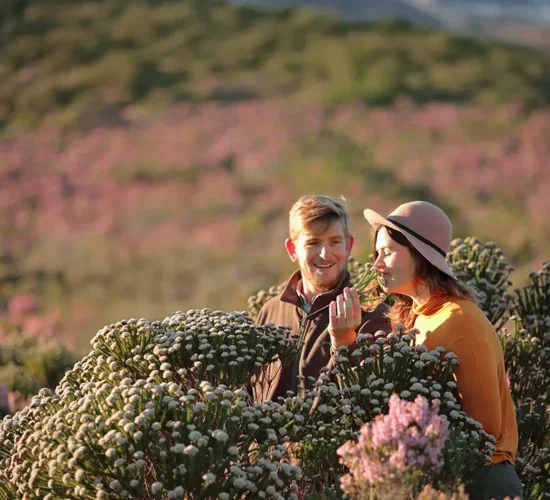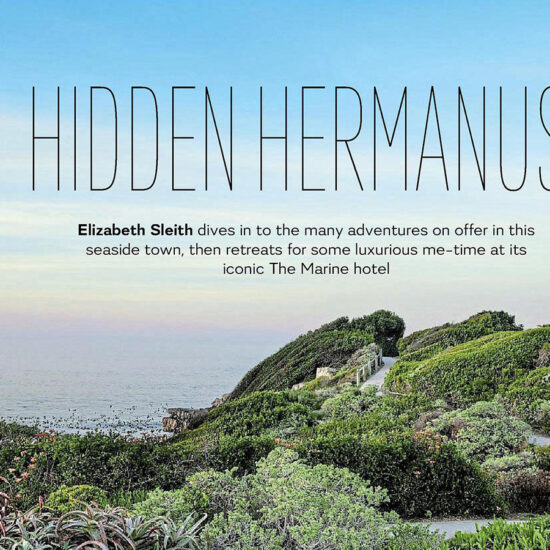The Khoisan
An ancient world submerged as an African Atlantis*
The implications of DNA studies are that everyone in the world today can trace their ancestry back to an African origin. The unity of the human species is remarkable. H.J. and Janette Deacon, Human beginnings in South Africa, 1999 **
History in this part of the world begins long before modern man expanded from Africa and set foot in Europe. Officially we cannot use the word “history” here. Officially, history in Africa began in “pre-historical” times. Whatever the start-date of history, men and women, like you and I (homo sapiens sapiens), had created a decent living for themselves along the coast of Danger Point Peninsula, between 65’000 and 85’000 years ago. At such time Neanderthal-man was still the only representative of the genus “homo” in Europe. When exactly the “first” modern man walked the earth is not clear.
What is clear, is that the Klipgat Cave on the coast in De Kelders, a short distance to the east of Gansbaai, is one of the discovery places of the oldest remains of modern man. Such early remains have only been found in three other South African sites and in the Middle-East. Excavations in Klipgat Cave between 1969 and 1995 produced stone artifacts, preserved bone tools and human remains left by Middle Stone Age people between 65’000 and 85’000 years ago. At such time the Klipgat Cave was at an estimated distance of 5 km from the ocean and not -as it is today- immediately on the ocean.
From these excavations it is also clear that about 2000 years ago, the Klipgat Cave was inhabited by the ancestors of the original residents of the Western Cape, the Khoisan. “Khoisan” is a combination of “San” and “Khoikhoi”. The San were the hunter gatherer communities that formed the sole populace of the Cape for thousands of years until, around 2000 years ago, the pastoralist Khoikhoi- communities moved into the Southernmost areas of Africa. A clear distinction over the past 2000 years between the two groups in the Cape, can however not be made. It seems that the Khoikhoi herders called any person without cattle “San”, irrespective of his heritage. In this sense “San” might have been equally applicable to a “Khoikhoi” who lost his cattle as to a “real” San. “San” it appears was an abusive word of Khoi-origin. With this in mind, it is more proper to use the name “Kung”, as this is what they called themselves. In the same manner, Dr. Cyril Hromnik, an expert on the early history of South Africa, argues that we should use “Quena” instead of “Khoikhoi”. When Jan van Riebeeck landed in the Cape and asked what the name was for all the people of the 16-odd tribes, the answer was Quena. “Khoikhoi”, Dr. Hromnik argues, is a name of academic and missionary origin without any support from historical records.
Whatever name one wants to use for the original residents of the Western Cape, very little is known about their history. Most of their history and culture has been lost in the course of the expansion of more dominant cultures. At the same time the genes of the Quena and the Kung are represented in all South African peoples and especially in the “coloured” people, whose identity is primarily of Quena/Kung origin. A most remarkable aspect of their language has also survived: The Nguni languages of Southern Africa, Xhosa, Zulu and Swazi inherited their click sounds from the Quena and the Kung languages.
Dr. Hromnik attempts to fill some of the holes in this lost history and culture. Pointing to archeological evidence that he claims has been ignored or misinterpreted by “mainstream” scientists, and comparing customs, language and religions of cultures, Hromnik asserts that there are parallels between Quena culture and the Dravidian culture from South India. Indeed some of the words of Quena origin, some still in use today, have a striking similarity to Indian words, such as the word “Karoo”, meaning “dry land” in Quena, practically identical to the Indian word for dry land: Karu. Engravings in a cave near Montagu of an Indian war chariot should also indicate trade or cultural contact between the Quena and India.
Hromnik states further that the meanings the Quena give to their god (“Gaura”), is a perfect match with the god Siva of the Hindu, one of whose epithets, Gauara, is practically identical with the Gaura of the Quena. The main Dravidian god (Gora, Gaura or Siva) is the god and protector of herders and hunters and -as such- could well meet the religious needs of the Quena herders and the Kung hunters.
The Klipgat Cave excavations produced the earliest sheep bones in the Western Cape, indicating that local Quena were keeping sheep some 2000 years ago. Apart from the earliest pottery in the Western Cape, the Klipgat Cave excavations also came up with numerous bone tools, ornaments and remains of bones of large herbivores, such as the Eland and the extinct Blue antelope. Wildlife in this area was abundant until white settlers moved in and in a short period of time hunted the “Serengeti of the Western Cape” into near oblivion. Many lost and present geographical names (either original Quena/Kung names or Quena/Kung names translated into Afrikaans) point back to the abundance of animals. Examples are: Buffeljagsbaai (place of the Buffalo hunt / Kaukai), Little Lion River (Gaskikamka), Eland’s Path, Hartebeeskloof (gorge of the Hartebees), Wolvengat (Hole of the Wolf = brown hyena), Rhenosterfontein (Fountain of the [black] Rhino) and Bonteboksvlei (Bontebok-swamp).
Other caves and protected shelters, such as the more inland Bijneskrans cave, were the home of early Quena herders and evidence points towards communities of Quena flourishing over the ages around Danger Point Peninsula and its hinterland. An expedition sent in 1660 by Jan van Riebeeck to explore the hinterland of the Cape reported having met people of the Ghainokwa community at a place now called Baardskeerdersbos (20 km from Gansbaai). Not surprising since the river flowing through the fertile valley of Baardskeerdersbos is called Boesmansrivier (Bushman-river; Bushman being a derogatory name for Kung people). Quena people built several fish-traps along the shores around Danger Point Peninsula, many of which can still be recognized today.
The Chainouqua tribe of the Western Overberg (Danger Point and hinterland) and the Hessequa of the Central Overberg (Bredasdorp and surroundings) traded cattle with the Dutch East Indies Company as far back as 1660. The Overberg was however populated relatively late by white settlers and hence little was known about the Quena of this area. The local Quena had to give up their semi-nomadic life style after the passing of the “Hottentot Laws” by the colonial government in 1812. These laws forced the Quena to have a fixed address as well as a pass issued by a magistrate if they wanted to travel from one place to another.
Though there is some anecdotal evidence of singular persons surviving in caves in the area and here and there title deeds where given to Quena people for the land where they lived, for most Quena the only available means of existence during the 19th century was to be employed as a farm worker.
People of Quena descent are the founders of the Gansbaai fishing culture: in 1811 the first permanent fishing cottages in the area were erected under the Milkwoods in Stanfords Bay, a short distance from Gansbaai.
Of the coloured communities in the larger area, the Moravian mission village of Elim is the one with the most thoroughly researched history. This beautiful town, 30 km from Gansbaai was established in 1824. Meticulously kept archives show that the first 15 Quena people moved to Elim in 1824 and that there was a Quena (“Khoikhoi”) population of 563 in 1839.
The demise of the local Quena-culture occurred more or less at the same time as the extinction of two animal-species that once occurred in abundance on the plains between Gansbaai and Cape Agulhas: the large Bluebuck (or Blue Antelope) and the Guagga (as the Quena named the beast in imitation of its call). Both became extinct at the beginning of the 19th century. The Guagga, a relative of the zebra, occurred in a wider area and has been extensively described. The last Guagga died in the Amsterdam Zoo and still exists as a stuffed form of her former splendor. Of the Blue antelope however, endemic to the little traveled area of the Southern Overberg, practically nothing is known.
Sandy Gall, The Bushmen of Southern Africa – Slaughter of the Innocent
- IncludedThe Khoisan
- Not IncludedNatureRelaxationHobbyEnthusiastsFamily-fun




